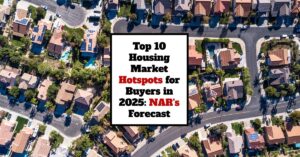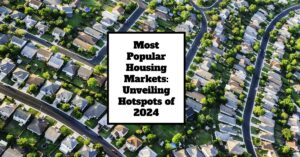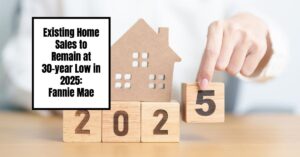If you're dreaming of owning a home in 2025, you're in luck! The National Association of Realtors (NAR) has just released its list of 10 housing market hotspots poised to outshine the rest of the country in sales next year. These aren't just random locations; they've been carefully selected based on strong economic, demographic, and housing factors that signal future market strength. So, if you're looking to buy, keep reading – these are the places to watch!
I've been tracking housing trends for a while now, and it's clear the market can be tricky. The past few years have been a rollercoaster, but the good news is that things seem to be stabilizing. Based on NAR's analysis and my own observations, 2025 is shaping up to be a better year for buyers. The key is to know where to look.
What Makes These Housing Markets Hot?
The NAR didn't just pick these 10 cities out of a hat. They looked at a variety of factors, including:
- Affordable Home Prices: Areas with a good mix of starter homes and generally lower prices are always attractive.
- Stable or Declining Mortgage Rates: As rates potentially settle around 6% next year, buyers will get a bit of breathing room.
- Strong Job Growth: A thriving local economy means more people can afford to buy and are also looking to settle down in the area.
- Net Migration: If an area is attracting new residents, the housing market tends to stay active.
- Fewer “Locked-In” Homeowners: This refers to people with older, lower-rate mortgages who are unlikely to sell. Fewer locked-in homeowners mean more homes for sale (more inventory).
NAR's Chief Economist, Lawrence Yun, put it well: “Important factors common among the top-performing markets in 2025 include available inventory at affordable price points, a better chance of unlocking low mortgage rates, higher income growth for young adults and net migration into specific metro areas.” He also believes that the “worst of the affordability challenges are over” as more inventory, stable mortgage rates and continued job and income growth pave the way for more Americans to achieve homeownership.
Top Housing Markets for Buyers in 2025: NAR's Expert Forecast
Here are NAR's 10 top housing hot spots for 2025 in alphabetical order. I'll share some insights based on my understanding of these areas, along with the data provided by NAR.
1. Boston-Cambridge-Newton, Massachusetts-New Hampshire
- Average Home Price: $694,494
- Why it's Hot: While Boston is pricey, there are a few key things that make it a hotspot for the coming year. NAR expects mortgage rates here to stabilize, which will likely reduce the number of locked-in homeowners, leading to more inventory. The area also features a good number of starter homes and mortgage rates that tend to be lower than the national average.
- My Thoughts: Boston is a great city with a vibrant economy. Although the prices are above the national average, the potential for job growth and the presence of starter homes makes it an interesting place for buyers. If you are considering buying here, make sure you have your finances in order.
2. Charlotte-Concord-Gastonia, North Carolina-South Carolina
- Average Home Price: Data not available, but 43% of homes are priced below $324,000
- Why it's Hot: Charlotte has seen 10% job growth in the past five years and a large share of affordable homes, with 43% priced below $324,000. The interest rate in the area is 6.85%, which is a little below the national average.
- My Thoughts: Charlotte's a rapidly growing city. Its combination of job growth and affordable housing makes it a very attractive option, particularly for families and young professionals. This is a market I would keep a close eye on!
3. Grand Rapids-Kentwood, Michigan
- Average Home Price: $271,960
- Why it's Hot: Grand Rapids offers affordable home prices, averaging around $271,960. While the mortgage rates are slightly higher than the national average, the area has fewer homeowners locked into lower mortgage rates, so more homes are likely to come on the market.
- My Thoughts: Grand Rapids has a lot going for it: lower cost of living, nice communities, and an opportunity to enter the housing market. If you're priced out of larger markets, it’s definitely worth considering.
4. Greenville-Anderson, South Carolina
- Average Home Price: $307,315
- Why it's Hot: Greenville boasts affordable average home prices at $307,315, coupled with homes selling quickly – about 17 days on the market. 42% of homes are starter homes, and despite slightly higher mortgage rates, the market continues to attract new residents.
- My Thoughts: Greenville's a good option for young families and professionals. The relatively affordable prices, and strong demand signal an opportunity for home buyers. Keep an eye on mortgage rate trends here, though.
5. Hartford-East Hartford-Middletown, Connecticut
- Average Home Price: $178,696
- Why it's Hot: The average home price is hard to beat at $178,696. The city had one of the lowest mortgage rates in 2023, at 6.5%, and the highest proportion of homeowners exceeding the average tenure of 17 years, which could lead to a rise in inventory.
- My Thoughts: Hartford's affordability is a big draw. It's a great choice if you are on a tighter budget and looking for value. The fact that many homeowners have been there for a while could mean good opportunities in 2025, with homes potentially coming on the market.
6. Indianapolis-Carmel-Anderson, Indiana
- Average Home Price: $223,261
- Why it's Hot: Indianapolis is another market with a good amount of affordable housing, with nearly 42% of homes priced under $236,000. The area has strong job growth and fewer locked-in homeowners.
- My Thoughts: Indianapolis is definitely one of the more affordable metros on this list. The strong job growth and ample supply of homes makes it a good choice for those looking to get into the housing market.
7. Kansas City, Missouri-Kansas
- Average Home Price: $233,826
- Why it's Hot: Kansas City has a favorable market due to a generally lower average mortgage rate, lower share of locked-in homeowners and affordable prices, with an average price of $233,826. About 30% of the millennial population can afford to buy in the area.
- My Thoughts: Kansas City has a good mix of affordability and economic opportunity. It's definitely worth considering, as the city is attracting many young people looking to get into the housing market for the first time.
8. Knoxville, Tennessee
- Average Home Price: $350,614
- Why it's Hot: Knoxville is a hot market, where approximately 50% of those moving in buy homes. The average home value of $350,614 makes it a comparatively affordable option, especially when you consider its location at the foothills of the Great Smoky Mountains.
- My Thoughts: Knoxville has a desirable lifestyle along with growing demand for housing. If you want to buy a home in an area with an outdoor lifestyle and affordable home prices then Knoxville will be on your radar.
9. Phoenix-Mesa-Chandler, Arizona
- Average Home Price: $414,977
- Why it's Hot: With an average home value of $414,977, the Phoenix area offers relatively affordable housing, lower cost of living, and strong job growth. Phoenix has become a popular place for people, particularly from California, to move to.
- My Thoughts: Phoenix continues to grow and attracts many new residents from expensive coastal areas. If you're looking for an area with a warm climate, affordability, and a lot of job opportunities, Phoenix may be the place for you.
10. San Antonio-New Braunfels, Texas
- Average Home Price: $250,834
- Why it's Hot: San Antonio has a growing job market and the average home price of $250,834 is below the national average. The cost of homes has decreased over the past year and the city continues to see a steady stream of new residents.
- My Thoughts: San Antonio is one of the fastest growing cities in the U.S. and the data suggests that the housing market is booming there. This is another market I'd be keeping an eye on due to its job growth and reasonable prices.
Key Takeaways & My Final Thoughts
As a homeowner and someone who's followed these markets for years, here are my main takeaways:
- Affordability is Key: The markets NAR has highlighted all have one thing in common – relative affordability, either in terms of overall price or in terms of a good share of starter homes.
- Don't Expect Dramatic Price Drops: While we may see prices stabilize, don’t expect home prices to fall through the floor.
- Mortgage Rates Will Likely Stabilize: The Federal Reserve is expected to continue cutting borrowing costs next year, and most experts expect the mortgage rates to settle around 6%. While it's not as low as some people are hoping, it's still better than what we've seen recently.
- Do Your Research: Even within these hot markets, it's essential to research specific neighborhoods, school districts, and local amenities to find the perfect fit for you and your family.
- Be Prepared to Move Quickly: In most of these areas, houses are moving fast, so be sure to have your financing in order and be ready to make an offer when you find the right place.
These are exciting markets, and I'm curious to see how they develop in 2025. Remember, the housing market is dynamic, so it's important to do your own research and not just follow general predictions blindly. Use these hotspots as a starting point and find the place that best suits your individual needs and preferences.
Work with Norada in 2025, Your Trusted Source for
Turnkey Investment Properties
Discover high-quality, ready-to-rent properties designed to deliver consistent returns.
Contact us today to expand your real estate portfolio with confidence.
Contact our investment counselors (No Obligation):
(800) 611-3060
Recommended Read:
- Most Popular Housing Markets: Unveiling Hotspots of 2024
- Existing Home Sales Predicted to Remain at 30-year Low in 2025
- Lower Mortgage Rates Will Reignite the Housing Demand in 2025
- NAR Predicts 6% Mortgage Rates in 2025 Will Boost Housing Market
- Housing Market Forecast for the Next 2 Years: 2024-2026
- Housing Market Predictions for the Next 4 Years: 2025 to 2028
- Housing Market Predictions for Next Year: Prices to Rise by 4.4%
- Housing Market Predictions for 2025 and 2026 by NAR Chief
- Real Estate Forecast Next 5 Years: Top 5 Predictions for Future
- Real Estate Forecast Next 10 Years: Will Prices Skyrocket?





